Tour Operations Management Report: Thomson Holidays Analysis
VerifiedAdded on 2020/01/28
|13
|3871
|60
Report
AI Summary
This report provides a comprehensive analysis of tour operations management, focusing on the impact of current trends like globalization, technology, and demographic changes on the travel and tourism industry. It explores the stages involved in developing holiday plans, specifically using the example of Thomson Holidays' South Africa tour package, including gathering data, cost analysis, service provider arrangements, legal requirements, and promotional strategies. The report also examines different methods of contracting for holiday components and calculates the costs associated with individual and family holiday packages. Furthermore, it discusses various distribution methods, such as direct sales, agents, partnerships, and online sales, used to sell holidays. Finally, the report analyzes strategic and tactical decisions made by tour operators, providing a detailed overview of the industry's complexities and operational strategies.
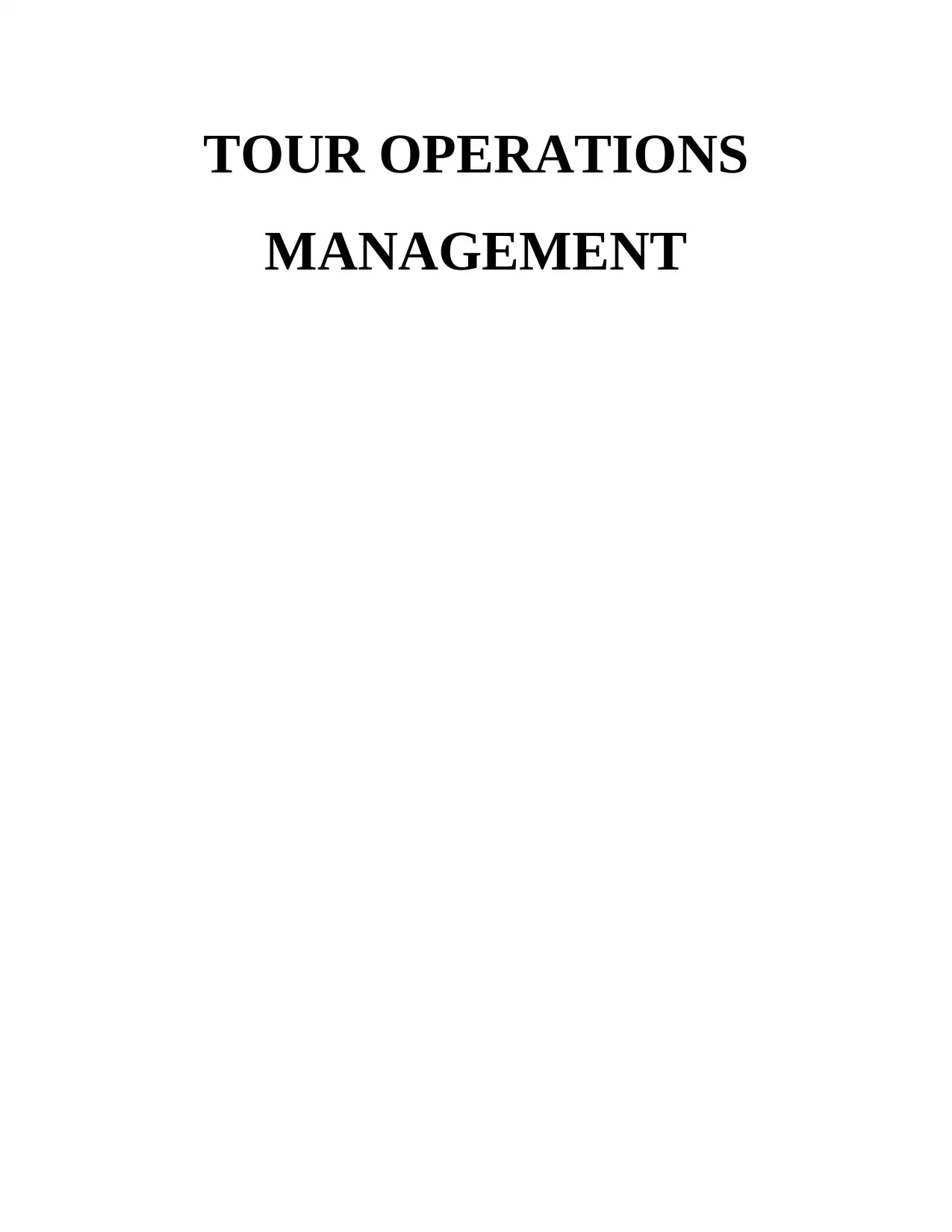
TOUR OPERATIONS
MANAGEMENT
MANAGEMENT
Paraphrase This Document
Need a fresh take? Get an instant paraphrase of this document with our AI Paraphraser
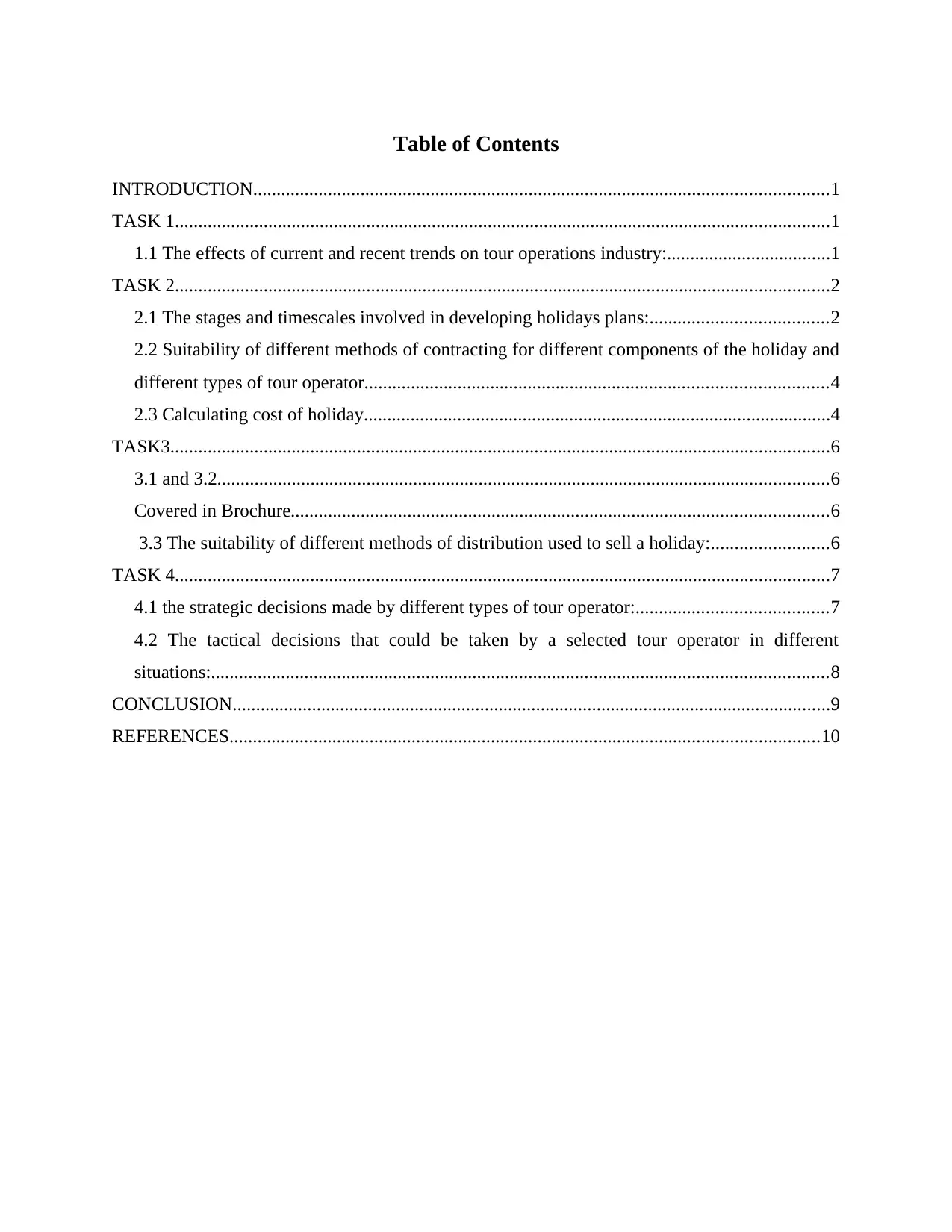
Table of Contents
INTRODUCTION...........................................................................................................................1
TASK 1............................................................................................................................................1
1.1 The effects of current and recent trends on tour operations industry:...................................1
TASK 2............................................................................................................................................2
2.1 The stages and timescales involved in developing holidays plans:......................................2
2.2 Suitability of different methods of contracting for different components of the holiday and
different types of tour operator...................................................................................................4
2.3 Calculating cost of holiday....................................................................................................4
TASK3.............................................................................................................................................6
3.1 and 3.2...................................................................................................................................6
Covered in Brochure...................................................................................................................6
3.3 The suitability of different methods of distribution used to sell a holiday:.........................6
TASK 4............................................................................................................................................7
4.1 the strategic decisions made by different types of tour operator:.........................................7
4.2 The tactical decisions that could be taken by a selected tour operator in different
situations:....................................................................................................................................8
CONCLUSION................................................................................................................................9
REFERENCES..............................................................................................................................10
INTRODUCTION...........................................................................................................................1
TASK 1............................................................................................................................................1
1.1 The effects of current and recent trends on tour operations industry:...................................1
TASK 2............................................................................................................................................2
2.1 The stages and timescales involved in developing holidays plans:......................................2
2.2 Suitability of different methods of contracting for different components of the holiday and
different types of tour operator...................................................................................................4
2.3 Calculating cost of holiday....................................................................................................4
TASK3.............................................................................................................................................6
3.1 and 3.2...................................................................................................................................6
Covered in Brochure...................................................................................................................6
3.3 The suitability of different methods of distribution used to sell a holiday:.........................6
TASK 4............................................................................................................................................7
4.1 the strategic decisions made by different types of tour operator:.........................................7
4.2 The tactical decisions that could be taken by a selected tour operator in different
situations:....................................................................................................................................8
CONCLUSION................................................................................................................................9
REFERENCES..............................................................................................................................10
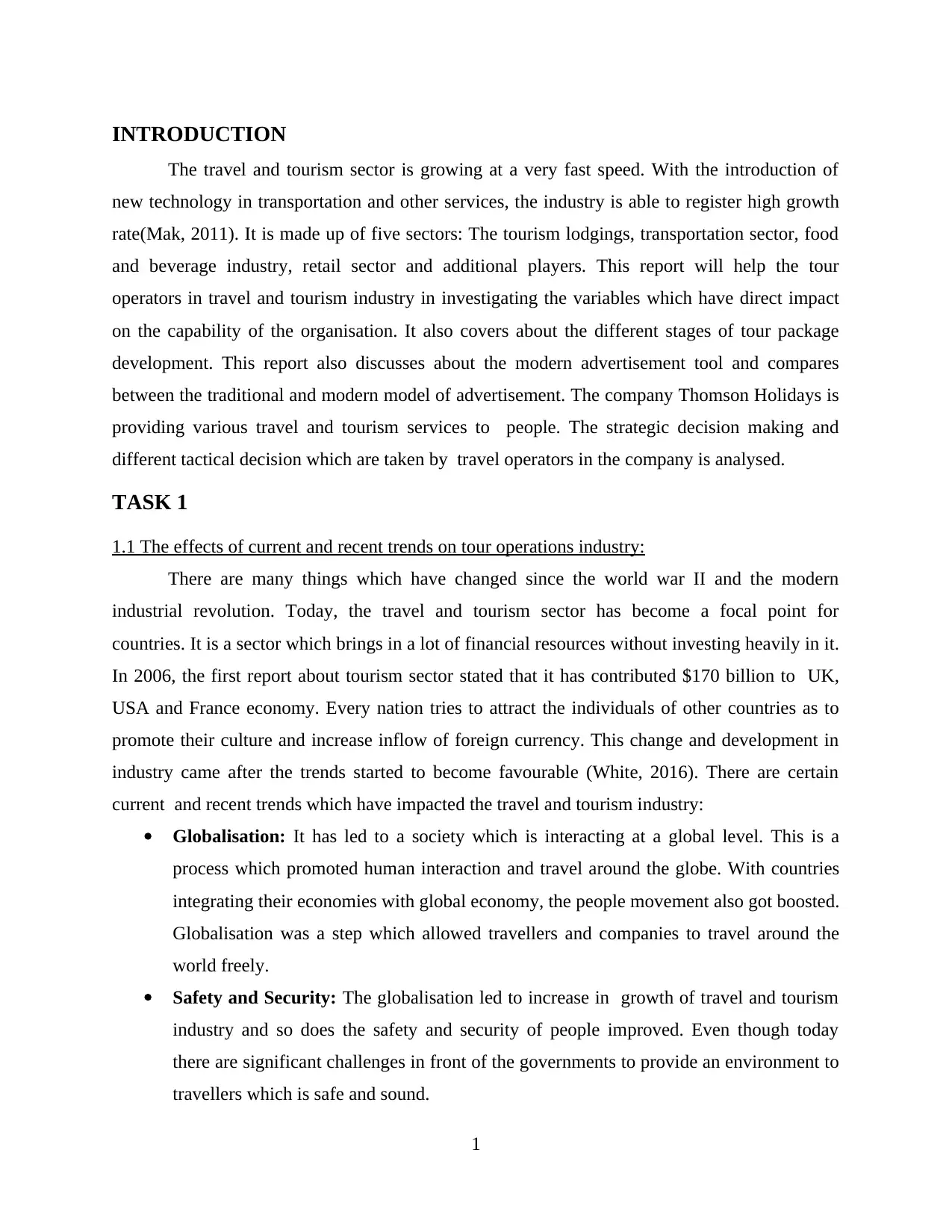
INTRODUCTION
The travel and tourism sector is growing at a very fast speed. With the introduction of
new technology in transportation and other services, the industry is able to register high growth
rate(Mak, 2011). It is made up of five sectors: The tourism lodgings, transportation sector, food
and beverage industry, retail sector and additional players. This report will help the tour
operators in travel and tourism industry in investigating the variables which have direct impact
on the capability of the organisation. It also covers about the different stages of tour package
development. This report also discusses about the modern advertisement tool and compares
between the traditional and modern model of advertisement. The company Thomson Holidays is
providing various travel and tourism services to people. The strategic decision making and
different tactical decision which are taken by travel operators in the company is analysed.
TASK 1
1.1 The effects of current and recent trends on tour operations industry:
There are many things which have changed since the world war II and the modern
industrial revolution. Today, the travel and tourism sector has become a focal point for
countries. It is a sector which brings in a lot of financial resources without investing heavily in it.
In 2006, the first report about tourism sector stated that it has contributed $170 billion to UK,
USA and France economy. Every nation tries to attract the individuals of other countries as to
promote their culture and increase inflow of foreign currency. This change and development in
industry came after the trends started to become favourable (White, 2016). There are certain
current and recent trends which have impacted the travel and tourism industry:
Globalisation: It has led to a society which is interacting at a global level. This is a
process which promoted human interaction and travel around the globe. With countries
integrating their economies with global economy, the people movement also got boosted.
Globalisation was a step which allowed travellers and companies to travel around the
world freely.
Safety and Security: The globalisation led to increase in growth of travel and tourism
industry and so does the safety and security of people improved. Even though today
there are significant challenges in front of the governments to provide an environment to
travellers which is safe and sound.
1
The travel and tourism sector is growing at a very fast speed. With the introduction of
new technology in transportation and other services, the industry is able to register high growth
rate(Mak, 2011). It is made up of five sectors: The tourism lodgings, transportation sector, food
and beverage industry, retail sector and additional players. This report will help the tour
operators in travel and tourism industry in investigating the variables which have direct impact
on the capability of the organisation. It also covers about the different stages of tour package
development. This report also discusses about the modern advertisement tool and compares
between the traditional and modern model of advertisement. The company Thomson Holidays is
providing various travel and tourism services to people. The strategic decision making and
different tactical decision which are taken by travel operators in the company is analysed.
TASK 1
1.1 The effects of current and recent trends on tour operations industry:
There are many things which have changed since the world war II and the modern
industrial revolution. Today, the travel and tourism sector has become a focal point for
countries. It is a sector which brings in a lot of financial resources without investing heavily in it.
In 2006, the first report about tourism sector stated that it has contributed $170 billion to UK,
USA and France economy. Every nation tries to attract the individuals of other countries as to
promote their culture and increase inflow of foreign currency. This change and development in
industry came after the trends started to become favourable (White, 2016). There are certain
current and recent trends which have impacted the travel and tourism industry:
Globalisation: It has led to a society which is interacting at a global level. This is a
process which promoted human interaction and travel around the globe. With countries
integrating their economies with global economy, the people movement also got boosted.
Globalisation was a step which allowed travellers and companies to travel around the
world freely.
Safety and Security: The globalisation led to increase in growth of travel and tourism
industry and so does the safety and security of people improved. Even though today
there are significant challenges in front of the governments to provide an environment to
travellers which is safe and sound.
1
⊘ This is a preview!⊘
Do you want full access?
Subscribe today to unlock all pages.

Trusted by 1+ million students worldwide
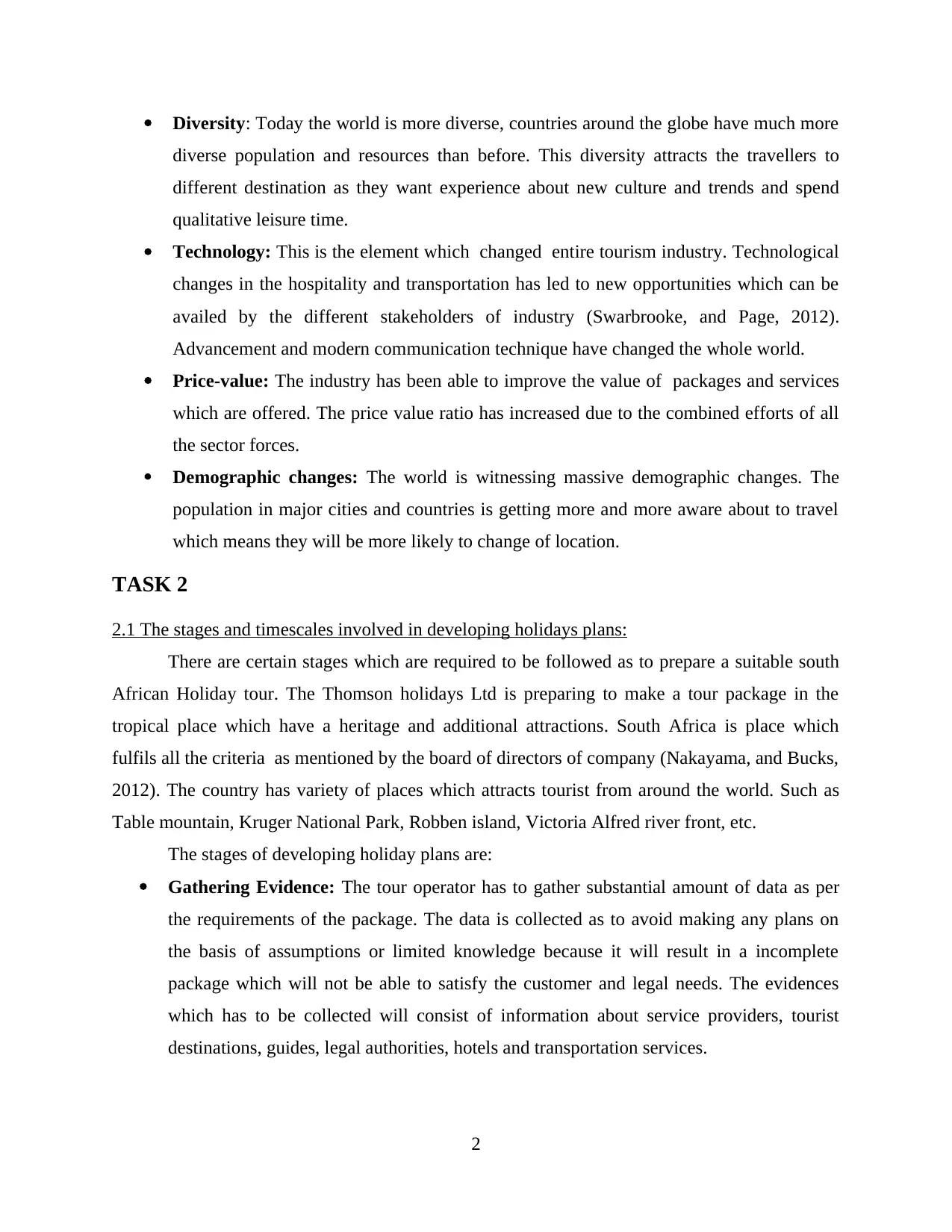
Diversity: Today the world is more diverse, countries around the globe have much more
diverse population and resources than before. This diversity attracts the travellers to
different destination as they want experience about new culture and trends and spend
qualitative leisure time.
Technology: This is the element which changed entire tourism industry. Technological
changes in the hospitality and transportation has led to new opportunities which can be
availed by the different stakeholders of industry (Swarbrooke, and Page, 2012).
Advancement and modern communication technique have changed the whole world.
Price-value: The industry has been able to improve the value of packages and services
which are offered. The price value ratio has increased due to the combined efforts of all
the sector forces.
Demographic changes: The world is witnessing massive demographic changes. The
population in major cities and countries is getting more and more aware about to travel
which means they will be more likely to change of location.
TASK 2
2.1 The stages and timescales involved in developing holidays plans:
There are certain stages which are required to be followed as to prepare a suitable south
African Holiday tour. The Thomson holidays Ltd is preparing to make a tour package in the
tropical place which have a heritage and additional attractions. South Africa is place which
fulfils all the criteria as mentioned by the board of directors of company (Nakayama, and Bucks,
2012). The country has variety of places which attracts tourist from around the world. Such as
Table mountain, Kruger National Park, Robben island, Victoria Alfred river front, etc.
The stages of developing holiday plans are:
Gathering Evidence: The tour operator has to gather substantial amount of data as per
the requirements of the package. The data is collected as to avoid making any plans on
the basis of assumptions or limited knowledge because it will result in a incomplete
package which will not be able to satisfy the customer and legal needs. The evidences
which has to be collected will consist of information about service providers, tourist
destinations, guides, legal authorities, hotels and transportation services.
2
diverse population and resources than before. This diversity attracts the travellers to
different destination as they want experience about new culture and trends and spend
qualitative leisure time.
Technology: This is the element which changed entire tourism industry. Technological
changes in the hospitality and transportation has led to new opportunities which can be
availed by the different stakeholders of industry (Swarbrooke, and Page, 2012).
Advancement and modern communication technique have changed the whole world.
Price-value: The industry has been able to improve the value of packages and services
which are offered. The price value ratio has increased due to the combined efforts of all
the sector forces.
Demographic changes: The world is witnessing massive demographic changes. The
population in major cities and countries is getting more and more aware about to travel
which means they will be more likely to change of location.
TASK 2
2.1 The stages and timescales involved in developing holidays plans:
There are certain stages which are required to be followed as to prepare a suitable south
African Holiday tour. The Thomson holidays Ltd is preparing to make a tour package in the
tropical place which have a heritage and additional attractions. South Africa is place which
fulfils all the criteria as mentioned by the board of directors of company (Nakayama, and Bucks,
2012). The country has variety of places which attracts tourist from around the world. Such as
Table mountain, Kruger National Park, Robben island, Victoria Alfred river front, etc.
The stages of developing holiday plans are:
Gathering Evidence: The tour operator has to gather substantial amount of data as per
the requirements of the package. The data is collected as to avoid making any plans on
the basis of assumptions or limited knowledge because it will result in a incomplete
package which will not be able to satisfy the customer and legal needs. The evidences
which has to be collected will consist of information about service providers, tourist
destinations, guides, legal authorities, hotels and transportation services.
2
Paraphrase This Document
Need a fresh take? Get an instant paraphrase of this document with our AI Paraphraser
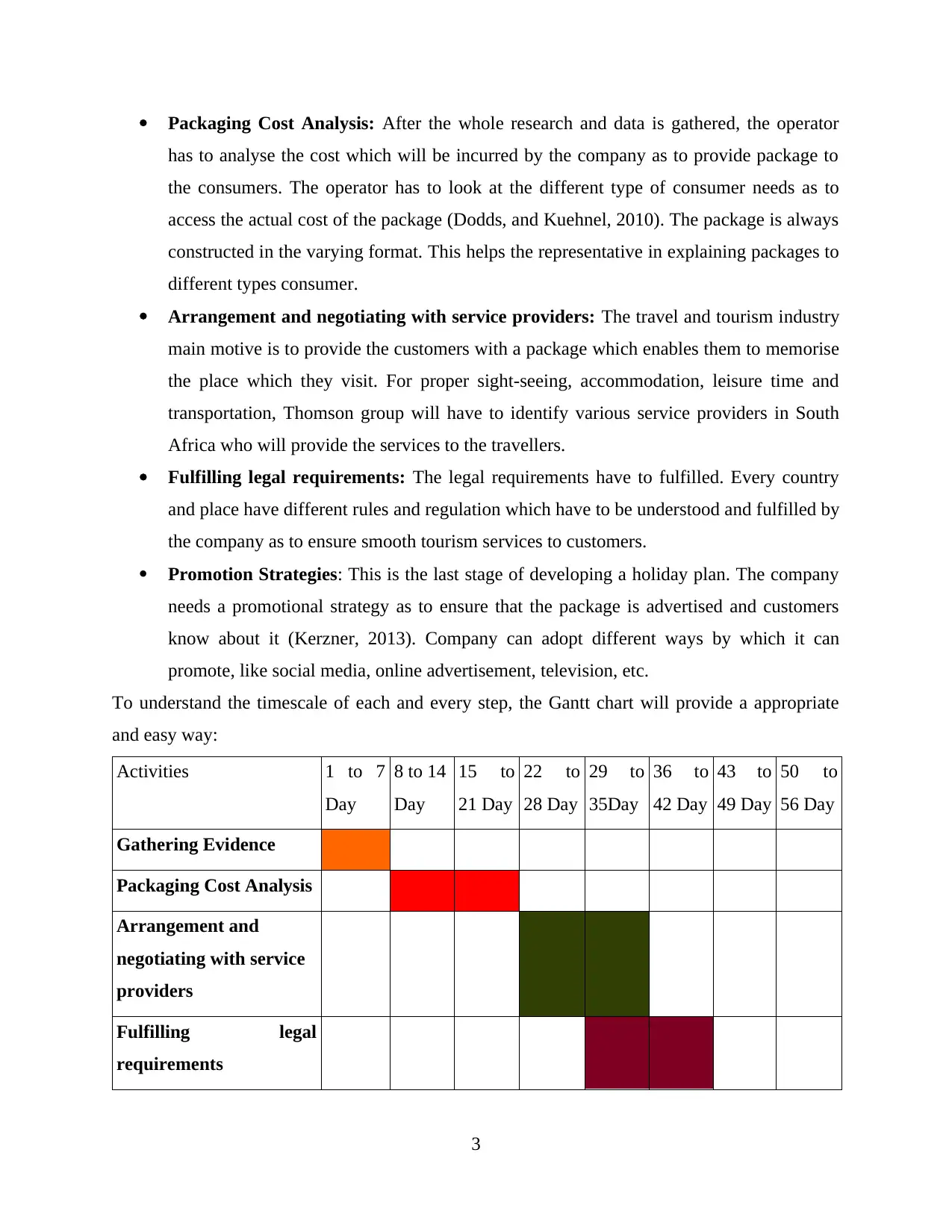
Packaging Cost Analysis: After the whole research and data is gathered, the operator
has to analyse the cost which will be incurred by the company as to provide package to
the consumers. The operator has to look at the different type of consumer needs as to
access the actual cost of the package (Dodds, and Kuehnel, 2010). The package is always
constructed in the varying format. This helps the representative in explaining packages to
different types consumer.
Arrangement and negotiating with service providers: The travel and tourism industry
main motive is to provide the customers with a package which enables them to memorise
the place which they visit. For proper sight-seeing, accommodation, leisure time and
transportation, Thomson group will have to identify various service providers in South
Africa who will provide the services to the travellers.
Fulfilling legal requirements: The legal requirements have to fulfilled. Every country
and place have different rules and regulation which have to be understood and fulfilled by
the company as to ensure smooth tourism services to customers.
Promotion Strategies: This is the last stage of developing a holiday plan. The company
needs a promotional strategy as to ensure that the package is advertised and customers
know about it (Kerzner, 2013). Company can adopt different ways by which it can
promote, like social media, online advertisement, television, etc.
To understand the timescale of each and every step, the Gantt chart will provide a appropriate
and easy way:
Activities 1 to 7
Day
8 to 14
Day
15 to
21 Day
22 to
28 Day
29 to
35Day
36 to
42 Day
43 to
49 Day
50 to
56 Day
Gathering Evidence
Packaging Cost Analysis
Arrangement and
negotiating with service
providers
Fulfilling legal
requirements
3
has to analyse the cost which will be incurred by the company as to provide package to
the consumers. The operator has to look at the different type of consumer needs as to
access the actual cost of the package (Dodds, and Kuehnel, 2010). The package is always
constructed in the varying format. This helps the representative in explaining packages to
different types consumer.
Arrangement and negotiating with service providers: The travel and tourism industry
main motive is to provide the customers with a package which enables them to memorise
the place which they visit. For proper sight-seeing, accommodation, leisure time and
transportation, Thomson group will have to identify various service providers in South
Africa who will provide the services to the travellers.
Fulfilling legal requirements: The legal requirements have to fulfilled. Every country
and place have different rules and regulation which have to be understood and fulfilled by
the company as to ensure smooth tourism services to customers.
Promotion Strategies: This is the last stage of developing a holiday plan. The company
needs a promotional strategy as to ensure that the package is advertised and customers
know about it (Kerzner, 2013). Company can adopt different ways by which it can
promote, like social media, online advertisement, television, etc.
To understand the timescale of each and every step, the Gantt chart will provide a appropriate
and easy way:
Activities 1 to 7
Day
8 to 14
Day
15 to
21 Day
22 to
28 Day
29 to
35Day
36 to
42 Day
43 to
49 Day
50 to
56 Day
Gathering Evidence
Packaging Cost Analysis
Arrangement and
negotiating with service
providers
Fulfilling legal
requirements
3
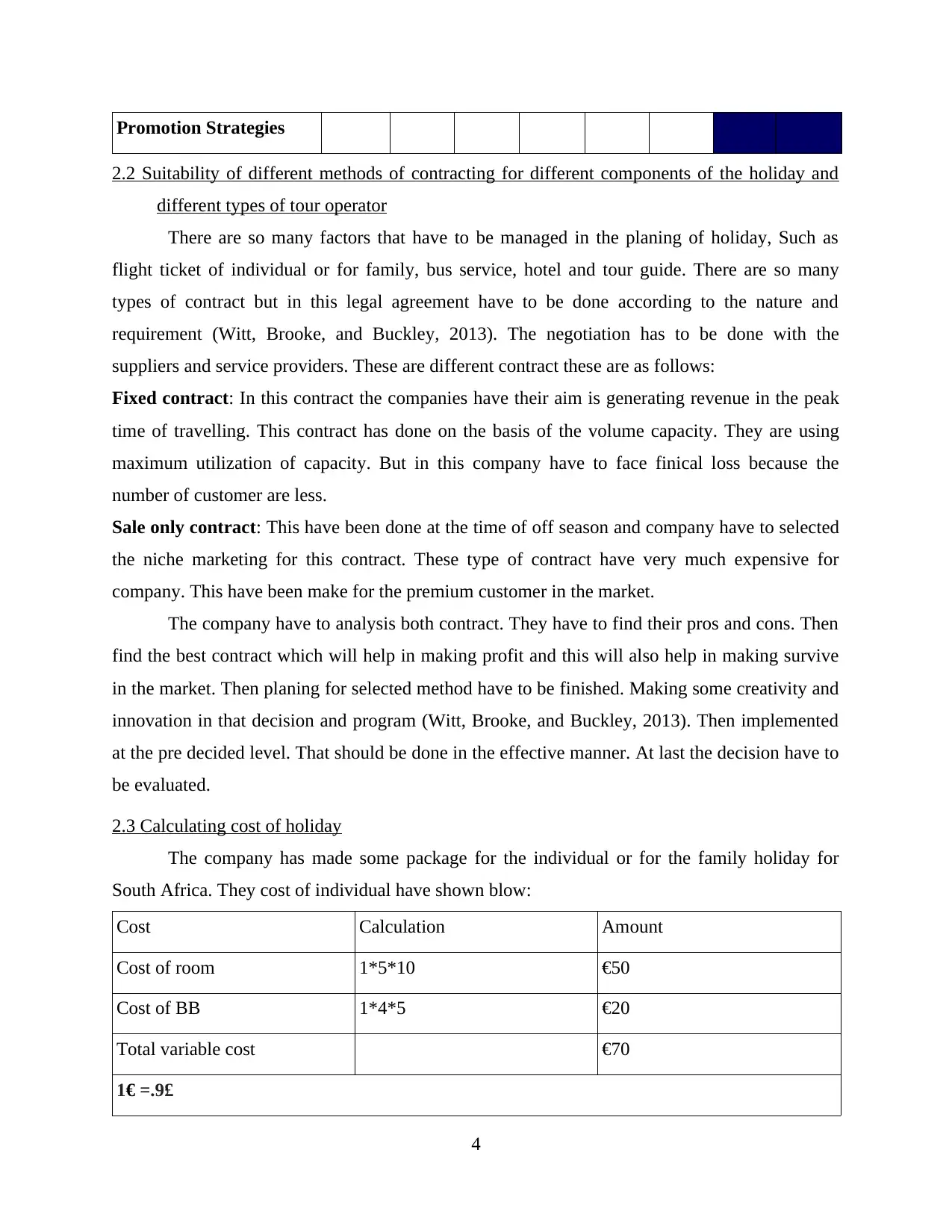
Promotion Strategies
2.2 Suitability of different methods of contracting for different components of the holiday and
different types of tour operator
There are so many factors that have to be managed in the planing of holiday, Such as
flight ticket of individual or for family, bus service, hotel and tour guide. There are so many
types of contract but in this legal agreement have to be done according to the nature and
requirement (Witt, Brooke, and Buckley, 2013). The negotiation has to be done with the
suppliers and service providers. These are different contract these are as follows:
Fixed contract: In this contract the companies have their aim is generating revenue in the peak
time of travelling. This contract has done on the basis of the volume capacity. They are using
maximum utilization of capacity. But in this company have to face finical loss because the
number of customer are less.
Sale only contract: This have been done at the time of off season and company have to selected
the niche marketing for this contract. These type of contract have very much expensive for
company. This have been make for the premium customer in the market.
The company have to analysis both contract. They have to find their pros and cons. Then
find the best contract which will help in making profit and this will also help in making survive
in the market. Then planing for selected method have to be finished. Making some creativity and
innovation in that decision and program (Witt, Brooke, and Buckley, 2013). Then implemented
at the pre decided level. That should be done in the effective manner. At last the decision have to
be evaluated.
2.3 Calculating cost of holiday
The company has made some package for the individual or for the family holiday for
South Africa. They cost of individual have shown blow:
Cost Calculation Amount
Cost of room 1*5*10 €50
Cost of BB 1*4*5 €20
Total variable cost €70
1€ =.9£
4
2.2 Suitability of different methods of contracting for different components of the holiday and
different types of tour operator
There are so many factors that have to be managed in the planing of holiday, Such as
flight ticket of individual or for family, bus service, hotel and tour guide. There are so many
types of contract but in this legal agreement have to be done according to the nature and
requirement (Witt, Brooke, and Buckley, 2013). The negotiation has to be done with the
suppliers and service providers. These are different contract these are as follows:
Fixed contract: In this contract the companies have their aim is generating revenue in the peak
time of travelling. This contract has done on the basis of the volume capacity. They are using
maximum utilization of capacity. But in this company have to face finical loss because the
number of customer are less.
Sale only contract: This have been done at the time of off season and company have to selected
the niche marketing for this contract. These type of contract have very much expensive for
company. This have been make for the premium customer in the market.
The company have to analysis both contract. They have to find their pros and cons. Then
find the best contract which will help in making profit and this will also help in making survive
in the market. Then planing for selected method have to be finished. Making some creativity and
innovation in that decision and program (Witt, Brooke, and Buckley, 2013). Then implemented
at the pre decided level. That should be done in the effective manner. At last the decision have to
be evaluated.
2.3 Calculating cost of holiday
The company has made some package for the individual or for the family holiday for
South Africa. They cost of individual have shown blow:
Cost Calculation Amount
Cost of room 1*5*10 €50
Cost of BB 1*4*5 €20
Total variable cost €70
1€ =.9£
4
⊘ This is a preview!⊘
Do you want full access?
Subscribe today to unlock all pages.

Trusted by 1+ million students worldwide
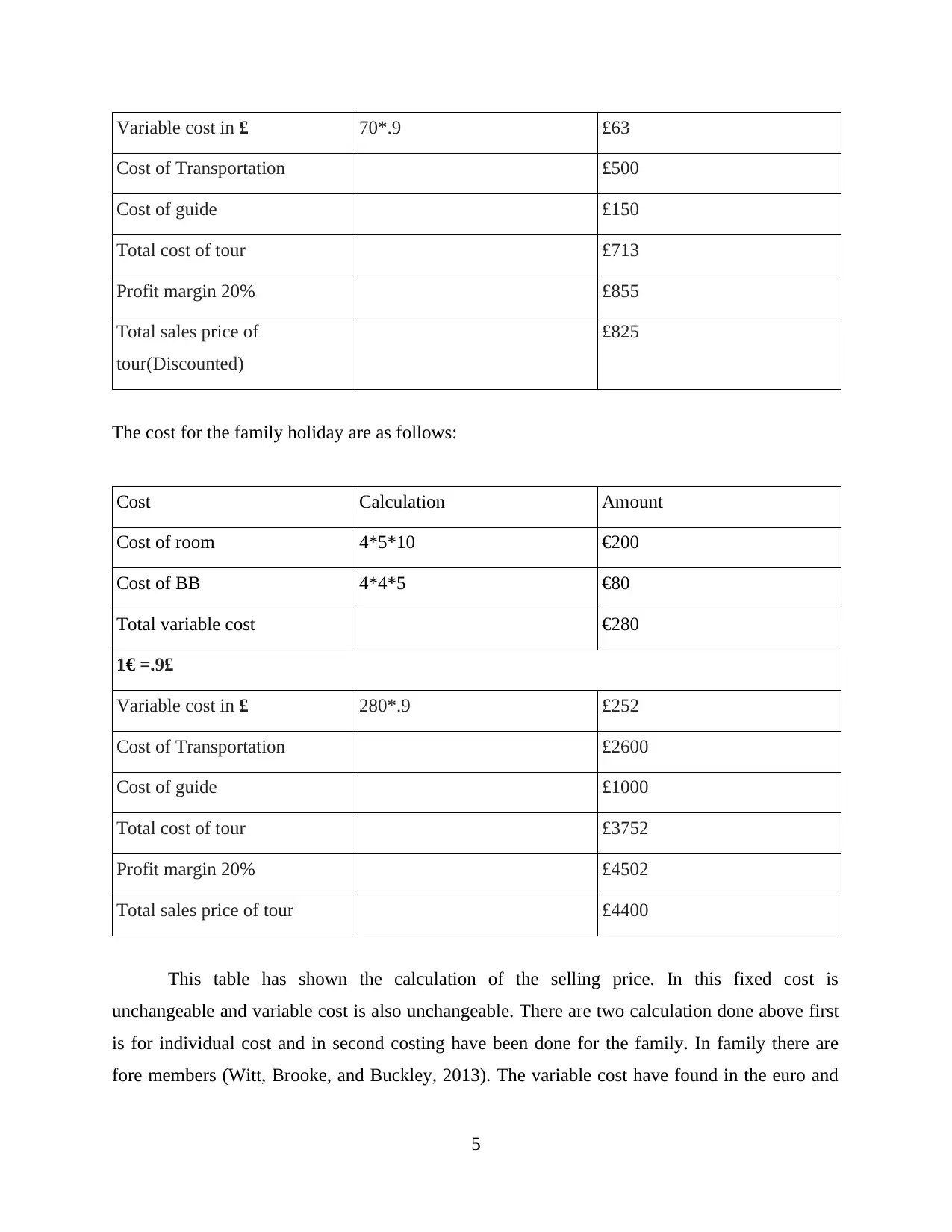
Variable cost in £ 70*.9 £63
Cost of Transportation £500
Cost of guide £150
Total cost of tour £713
Profit margin 20% £855
Total sales price of
tour(Discounted)
£825
The cost for the family holiday are as follows:
Cost Calculation Amount
Cost of room 4*5*10 €200
Cost of BB 4*4*5 €80
Total variable cost €280
1€ =.9£
Variable cost in £ 280*.9 £252
Cost of Transportation £2600
Cost of guide £1000
Total cost of tour £3752
Profit margin 20% £4502
Total sales price of tour £4400
This table has shown the calculation of the selling price. In this fixed cost is
unchangeable and variable cost is also unchangeable. There are two calculation done above first
is for individual cost and in second costing have been done for the family. In family there are
fore members (Witt, Brooke, and Buckley, 2013). The variable cost have found in the euro and
5
Cost of Transportation £500
Cost of guide £150
Total cost of tour £713
Profit margin 20% £855
Total sales price of
tour(Discounted)
£825
The cost for the family holiday are as follows:
Cost Calculation Amount
Cost of room 4*5*10 €200
Cost of BB 4*4*5 €80
Total variable cost €280
1€ =.9£
Variable cost in £ 280*.9 £252
Cost of Transportation £2600
Cost of guide £1000
Total cost of tour £3752
Profit margin 20% £4502
Total sales price of tour £4400
This table has shown the calculation of the selling price. In this fixed cost is
unchangeable and variable cost is also unchangeable. There are two calculation done above first
is for individual cost and in second costing have been done for the family. In family there are
fore members (Witt, Brooke, and Buckley, 2013). The variable cost have found in the euro and
5
Paraphrase This Document
Need a fresh take? Get an instant paraphrase of this document with our AI Paraphraser
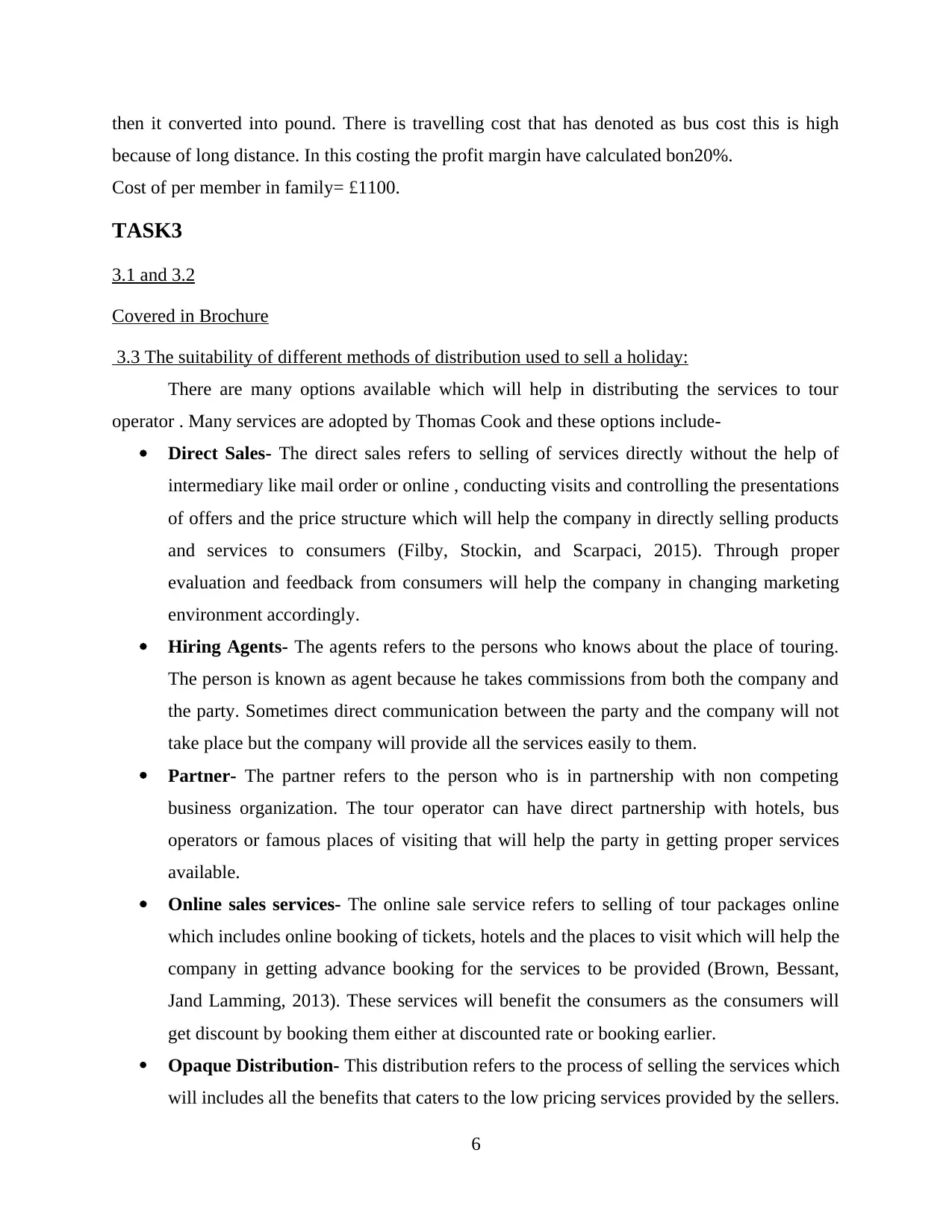
then it converted into pound. There is travelling cost that has denoted as bus cost this is high
because of long distance. In this costing the profit margin have calculated bon20%.
Cost of per member in family= £1100.
TASK3
3.1 and 3.2
Covered in Brochure
3.3 The suitability of different methods of distribution used to sell a holiday:
There are many options available which will help in distributing the services to tour
operator . Many services are adopted by Thomas Cook and these options include-
Direct Sales- The direct sales refers to selling of services directly without the help of
intermediary like mail order or online , conducting visits and controlling the presentations
of offers and the price structure which will help the company in directly selling products
and services to consumers (Filby, Stockin, and Scarpaci, 2015). Through proper
evaluation and feedback from consumers will help the company in changing marketing
environment accordingly.
Hiring Agents- The agents refers to the persons who knows about the place of touring.
The person is known as agent because he takes commissions from both the company and
the party. Sometimes direct communication between the party and the company will not
take place but the company will provide all the services easily to them.
Partner- The partner refers to the person who is in partnership with non competing
business organization. The tour operator can have direct partnership with hotels, bus
operators or famous places of visiting that will help the party in getting proper services
available.
Online sales services- The online sale service refers to selling of tour packages online
which includes online booking of tickets, hotels and the places to visit which will help the
company in getting advance booking for the services to be provided (Brown, Bessant,
Jand Lamming, 2013). These services will benefit the consumers as the consumers will
get discount by booking them either at discounted rate or booking earlier.
Opaque Distribution- This distribution refers to the process of selling the services which
will includes all the benefits that caters to the low pricing services provided by the sellers.
6
because of long distance. In this costing the profit margin have calculated bon20%.
Cost of per member in family= £1100.
TASK3
3.1 and 3.2
Covered in Brochure
3.3 The suitability of different methods of distribution used to sell a holiday:
There are many options available which will help in distributing the services to tour
operator . Many services are adopted by Thomas Cook and these options include-
Direct Sales- The direct sales refers to selling of services directly without the help of
intermediary like mail order or online , conducting visits and controlling the presentations
of offers and the price structure which will help the company in directly selling products
and services to consumers (Filby, Stockin, and Scarpaci, 2015). Through proper
evaluation and feedback from consumers will help the company in changing marketing
environment accordingly.
Hiring Agents- The agents refers to the persons who knows about the place of touring.
The person is known as agent because he takes commissions from both the company and
the party. Sometimes direct communication between the party and the company will not
take place but the company will provide all the services easily to them.
Partner- The partner refers to the person who is in partnership with non competing
business organization. The tour operator can have direct partnership with hotels, bus
operators or famous places of visiting that will help the party in getting proper services
available.
Online sales services- The online sale service refers to selling of tour packages online
which includes online booking of tickets, hotels and the places to visit which will help the
company in getting advance booking for the services to be provided (Brown, Bessant,
Jand Lamming, 2013). These services will benefit the consumers as the consumers will
get discount by booking them either at discounted rate or booking earlier.
Opaque Distribution- This distribution refers to the process of selling the services which
will includes all the benefits that caters to the low pricing services provided by the sellers.
6
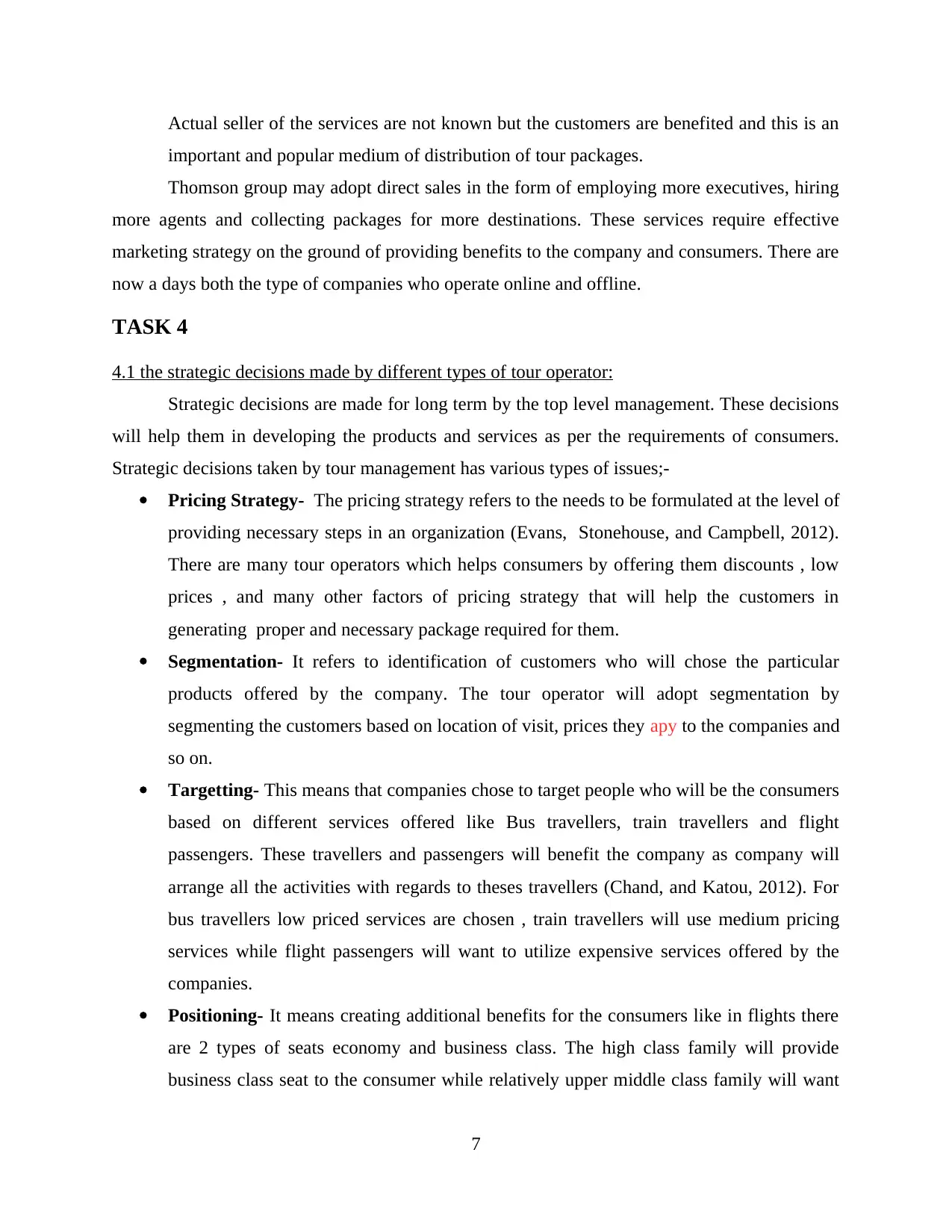
Actual seller of the services are not known but the customers are benefited and this is an
important and popular medium of distribution of tour packages.
Thomson group may adopt direct sales in the form of employing more executives, hiring
more agents and collecting packages for more destinations. These services require effective
marketing strategy on the ground of providing benefits to the company and consumers. There are
now a days both the type of companies who operate online and offline.
TASK 4
4.1 the strategic decisions made by different types of tour operator:
Strategic decisions are made for long term by the top level management. These decisions
will help them in developing the products and services as per the requirements of consumers.
Strategic decisions taken by tour management has various types of issues;-
Pricing Strategy- The pricing strategy refers to the needs to be formulated at the level of
providing necessary steps in an organization (Evans, Stonehouse, and Campbell, 2012).
There are many tour operators which helps consumers by offering them discounts , low
prices , and many other factors of pricing strategy that will help the customers in
generating proper and necessary package required for them.
Segmentation- It refers to identification of customers who will chose the particular
products offered by the company. The tour operator will adopt segmentation by
segmenting the customers based on location of visit, prices they apy to the companies and
so on.
Targetting- This means that companies chose to target people who will be the consumers
based on different services offered like Bus travellers, train travellers and flight
passengers. These travellers and passengers will benefit the company as company will
arrange all the activities with regards to theses travellers (Chand, and Katou, 2012). For
bus travellers low priced services are chosen , train travellers will use medium pricing
services while flight passengers will want to utilize expensive services offered by the
companies.
Positioning- It means creating additional benefits for the consumers like in flights there
are 2 types of seats economy and business class. The high class family will provide
business class seat to the consumer while relatively upper middle class family will want
7
important and popular medium of distribution of tour packages.
Thomson group may adopt direct sales in the form of employing more executives, hiring
more agents and collecting packages for more destinations. These services require effective
marketing strategy on the ground of providing benefits to the company and consumers. There are
now a days both the type of companies who operate online and offline.
TASK 4
4.1 the strategic decisions made by different types of tour operator:
Strategic decisions are made for long term by the top level management. These decisions
will help them in developing the products and services as per the requirements of consumers.
Strategic decisions taken by tour management has various types of issues;-
Pricing Strategy- The pricing strategy refers to the needs to be formulated at the level of
providing necessary steps in an organization (Evans, Stonehouse, and Campbell, 2012).
There are many tour operators which helps consumers by offering them discounts , low
prices , and many other factors of pricing strategy that will help the customers in
generating proper and necessary package required for them.
Segmentation- It refers to identification of customers who will chose the particular
products offered by the company. The tour operator will adopt segmentation by
segmenting the customers based on location of visit, prices they apy to the companies and
so on.
Targetting- This means that companies chose to target people who will be the consumers
based on different services offered like Bus travellers, train travellers and flight
passengers. These travellers and passengers will benefit the company as company will
arrange all the activities with regards to theses travellers (Chand, and Katou, 2012). For
bus travellers low priced services are chosen , train travellers will use medium pricing
services while flight passengers will want to utilize expensive services offered by the
companies.
Positioning- It means creating additional benefits for the consumers like in flights there
are 2 types of seats economy and business class. The high class family will provide
business class seat to the consumer while relatively upper middle class family will want
7
⊘ This is a preview!⊘
Do you want full access?
Subscribe today to unlock all pages.

Trusted by 1+ million students worldwide
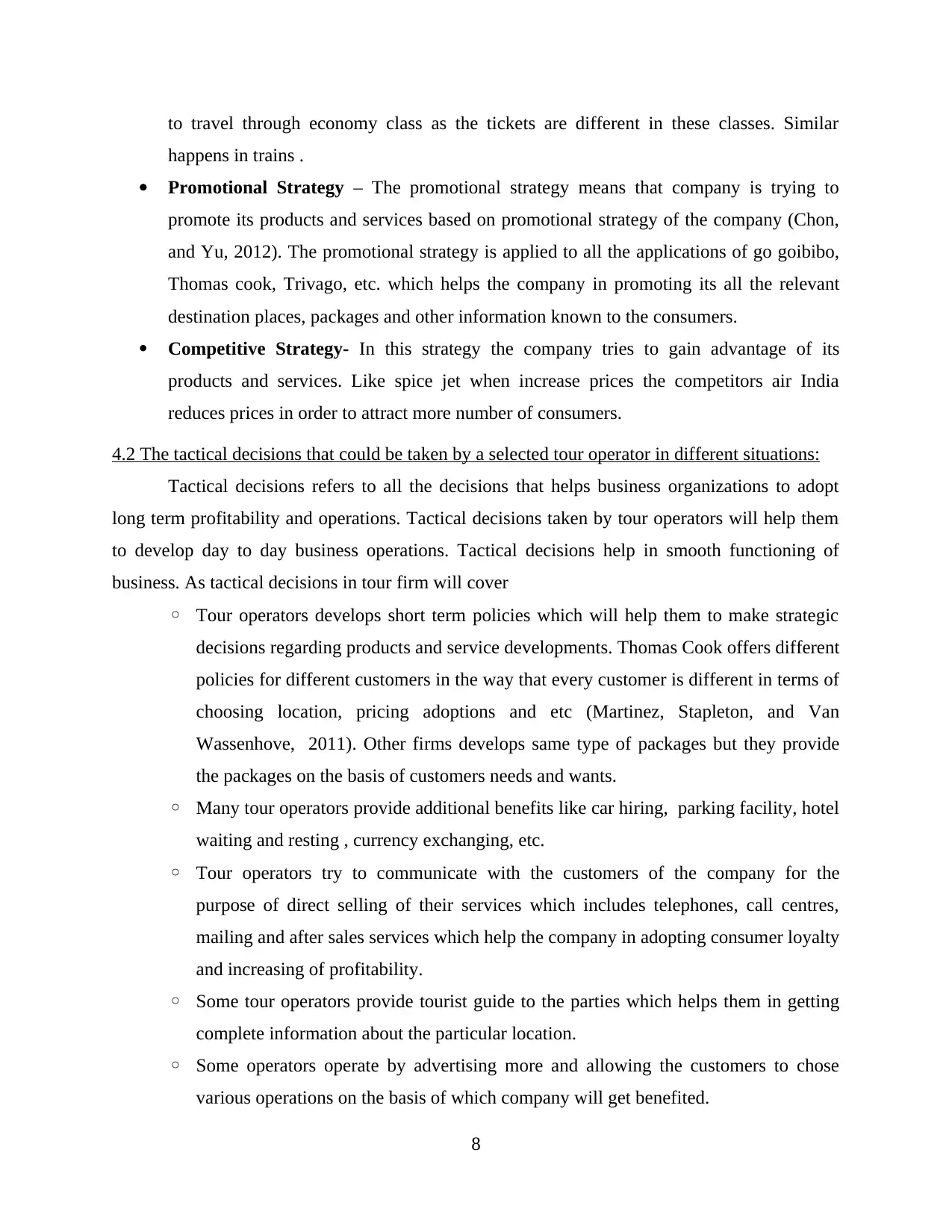
to travel through economy class as the tickets are different in these classes. Similar
happens in trains .
Promotional Strategy – The promotional strategy means that company is trying to
promote its products and services based on promotional strategy of the company (Chon,
and Yu, 2012). The promotional strategy is applied to all the applications of go goibibo,
Thomas cook, Trivago, etc. which helps the company in promoting its all the relevant
destination places, packages and other information known to the consumers.
Competitive Strategy- In this strategy the company tries to gain advantage of its
products and services. Like spice jet when increase prices the competitors air India
reduces prices in order to attract more number of consumers.
4.2 The tactical decisions that could be taken by a selected tour operator in different situations:
Tactical decisions refers to all the decisions that helps business organizations to adopt
long term profitability and operations. Tactical decisions taken by tour operators will help them
to develop day to day business operations. Tactical decisions help in smooth functioning of
business. As tactical decisions in tour firm will cover
◦ Tour operators develops short term policies which will help them to make strategic
decisions regarding products and service developments. Thomas Cook offers different
policies for different customers in the way that every customer is different in terms of
choosing location, pricing adoptions and etc (Martinez, Stapleton, and Van
Wassenhove, 2011). Other firms develops same type of packages but they provide
the packages on the basis of customers needs and wants.
◦ Many tour operators provide additional benefits like car hiring, parking facility, hotel
waiting and resting , currency exchanging, etc.
◦ Tour operators try to communicate with the customers of the company for the
purpose of direct selling of their services which includes telephones, call centres,
mailing and after sales services which help the company in adopting consumer loyalty
and increasing of profitability.
◦ Some tour operators provide tourist guide to the parties which helps them in getting
complete information about the particular location.
◦ Some operators operate by advertising more and allowing the customers to chose
various operations on the basis of which company will get benefited.
8
happens in trains .
Promotional Strategy – The promotional strategy means that company is trying to
promote its products and services based on promotional strategy of the company (Chon,
and Yu, 2012). The promotional strategy is applied to all the applications of go goibibo,
Thomas cook, Trivago, etc. which helps the company in promoting its all the relevant
destination places, packages and other information known to the consumers.
Competitive Strategy- In this strategy the company tries to gain advantage of its
products and services. Like spice jet when increase prices the competitors air India
reduces prices in order to attract more number of consumers.
4.2 The tactical decisions that could be taken by a selected tour operator in different situations:
Tactical decisions refers to all the decisions that helps business organizations to adopt
long term profitability and operations. Tactical decisions taken by tour operators will help them
to develop day to day business operations. Tactical decisions help in smooth functioning of
business. As tactical decisions in tour firm will cover
◦ Tour operators develops short term policies which will help them to make strategic
decisions regarding products and service developments. Thomas Cook offers different
policies for different customers in the way that every customer is different in terms of
choosing location, pricing adoptions and etc (Martinez, Stapleton, and Van
Wassenhove, 2011). Other firms develops same type of packages but they provide
the packages on the basis of customers needs and wants.
◦ Many tour operators provide additional benefits like car hiring, parking facility, hotel
waiting and resting , currency exchanging, etc.
◦ Tour operators try to communicate with the customers of the company for the
purpose of direct selling of their services which includes telephones, call centres,
mailing and after sales services which help the company in adopting consumer loyalty
and increasing of profitability.
◦ Some tour operators provide tourist guide to the parties which helps them in getting
complete information about the particular location.
◦ Some operators operate by advertising more and allowing the customers to chose
various operations on the basis of which company will get benefited.
8
Paraphrase This Document
Need a fresh take? Get an instant paraphrase of this document with our AI Paraphraser
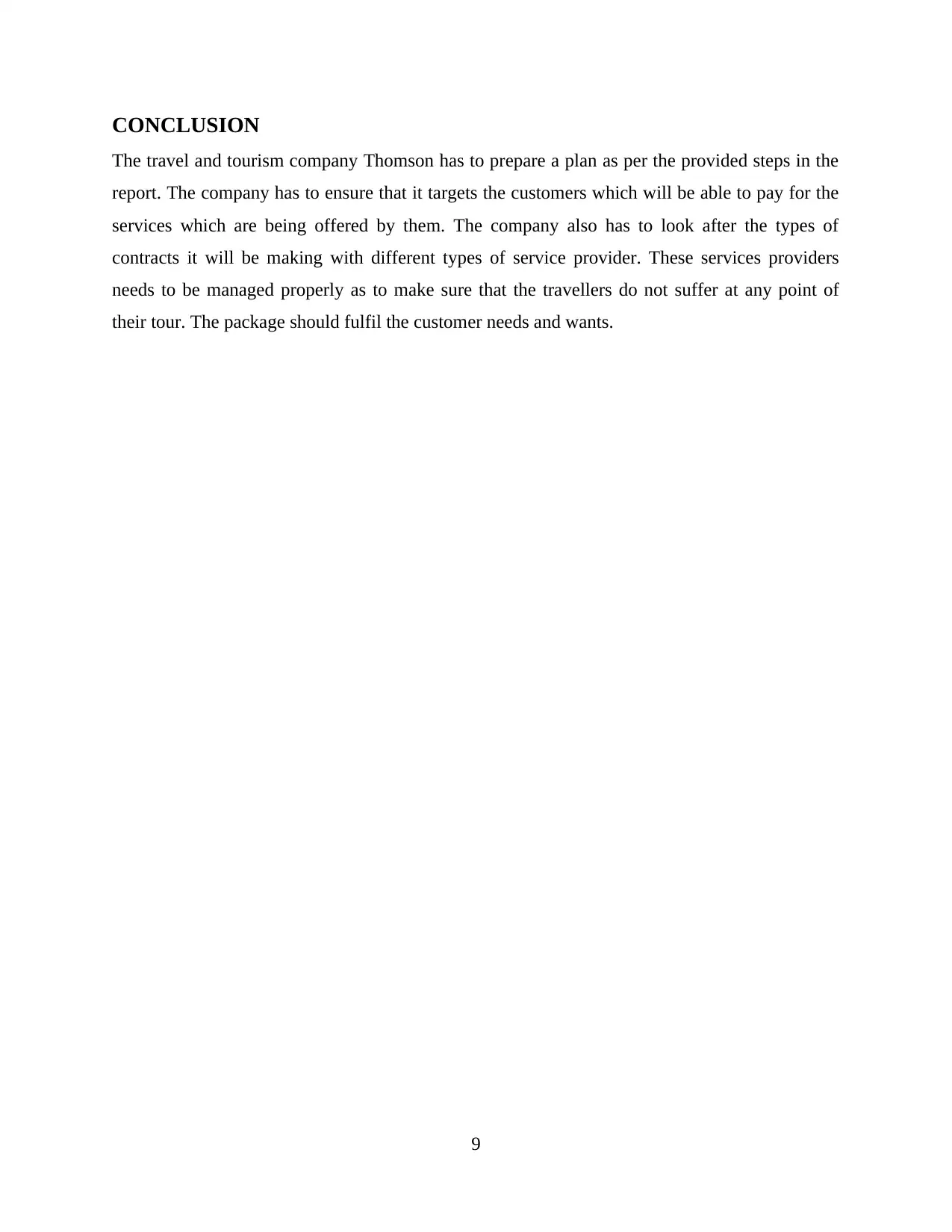
CONCLUSION
The travel and tourism company Thomson has to prepare a plan as per the provided steps in the
report. The company has to ensure that it targets the customers which will be able to pay for the
services which are being offered by them. The company also has to look after the types of
contracts it will be making with different types of service provider. These services providers
needs to be managed properly as to make sure that the travellers do not suffer at any point of
their tour. The package should fulfil the customer needs and wants.
9
The travel and tourism company Thomson has to prepare a plan as per the provided steps in the
report. The company has to ensure that it targets the customers which will be able to pay for the
services which are being offered by them. The company also has to look after the types of
contracts it will be making with different types of service provider. These services providers
needs to be managed properly as to make sure that the travellers do not suffer at any point of
their tour. The package should fulfil the customer needs and wants.
9
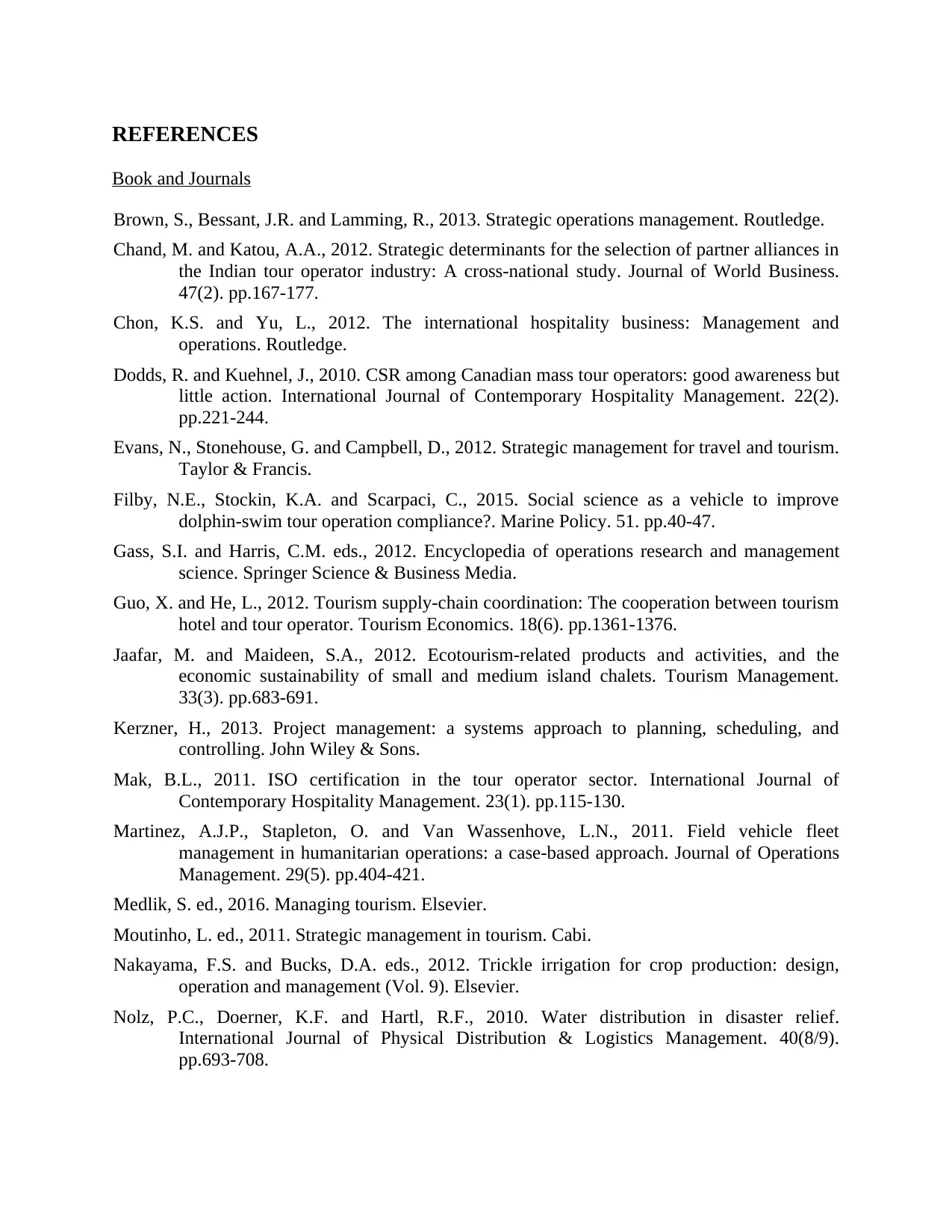
REFERENCES
Book and Journals
Brown, S., Bessant, J.R. and Lamming, R., 2013. Strategic operations management. Routledge.
Chand, M. and Katou, A.A., 2012. Strategic determinants for the selection of partner alliances in
the Indian tour operator industry: A cross-national study. Journal of World Business.
47(2). pp.167-177.
Chon, K.S. and Yu, L., 2012. The international hospitality business: Management and
operations. Routledge.
Dodds, R. and Kuehnel, J., 2010. CSR among Canadian mass tour operators: good awareness but
little action. International Journal of Contemporary Hospitality Management. 22(2).
pp.221-244.
Evans, N., Stonehouse, G. and Campbell, D., 2012. Strategic management for travel and tourism.
Taylor & Francis.
Filby, N.E., Stockin, K.A. and Scarpaci, C., 2015. Social science as a vehicle to improve
dolphin-swim tour operation compliance?. Marine Policy. 51. pp.40-47.
Gass, S.I. and Harris, C.M. eds., 2012. Encyclopedia of operations research and management
science. Springer Science & Business Media.
Guo, X. and He, L., 2012. Tourism supply-chain coordination: The cooperation between tourism
hotel and tour operator. Tourism Economics. 18(6). pp.1361-1376.
Jaafar, M. and Maideen, S.A., 2012. Ecotourism-related products and activities, and the
economic sustainability of small and medium island chalets. Tourism Management.
33(3). pp.683-691.
Kerzner, H., 2013. Project management: a systems approach to planning, scheduling, and
controlling. John Wiley & Sons.
Mak, B.L., 2011. ISO certification in the tour operator sector. International Journal of
Contemporary Hospitality Management. 23(1). pp.115-130.
Martinez, A.J.P., Stapleton, O. and Van Wassenhove, L.N., 2011. Field vehicle fleet
management in humanitarian operations: a case-based approach. Journal of Operations
Management. 29(5). pp.404-421.
Medlik, S. ed., 2016. Managing tourism. Elsevier.
Moutinho, L. ed., 2011. Strategic management in tourism. Cabi.
Nakayama, F.S. and Bucks, D.A. eds., 2012. Trickle irrigation for crop production: design,
operation and management (Vol. 9). Elsevier.
Nolz, P.C., Doerner, K.F. and Hartl, R.F., 2010. Water distribution in disaster relief.
International Journal of Physical Distribution & Logistics Management. 40(8/9).
pp.693-708.
Book and Journals
Brown, S., Bessant, J.R. and Lamming, R., 2013. Strategic operations management. Routledge.
Chand, M. and Katou, A.A., 2012. Strategic determinants for the selection of partner alliances in
the Indian tour operator industry: A cross-national study. Journal of World Business.
47(2). pp.167-177.
Chon, K.S. and Yu, L., 2012. The international hospitality business: Management and
operations. Routledge.
Dodds, R. and Kuehnel, J., 2010. CSR among Canadian mass tour operators: good awareness but
little action. International Journal of Contemporary Hospitality Management. 22(2).
pp.221-244.
Evans, N., Stonehouse, G. and Campbell, D., 2012. Strategic management for travel and tourism.
Taylor & Francis.
Filby, N.E., Stockin, K.A. and Scarpaci, C., 2015. Social science as a vehicle to improve
dolphin-swim tour operation compliance?. Marine Policy. 51. pp.40-47.
Gass, S.I. and Harris, C.M. eds., 2012. Encyclopedia of operations research and management
science. Springer Science & Business Media.
Guo, X. and He, L., 2012. Tourism supply-chain coordination: The cooperation between tourism
hotel and tour operator. Tourism Economics. 18(6). pp.1361-1376.
Jaafar, M. and Maideen, S.A., 2012. Ecotourism-related products and activities, and the
economic sustainability of small and medium island chalets. Tourism Management.
33(3). pp.683-691.
Kerzner, H., 2013. Project management: a systems approach to planning, scheduling, and
controlling. John Wiley & Sons.
Mak, B.L., 2011. ISO certification in the tour operator sector. International Journal of
Contemporary Hospitality Management. 23(1). pp.115-130.
Martinez, A.J.P., Stapleton, O. and Van Wassenhove, L.N., 2011. Field vehicle fleet
management in humanitarian operations: a case-based approach. Journal of Operations
Management. 29(5). pp.404-421.
Medlik, S. ed., 2016. Managing tourism. Elsevier.
Moutinho, L. ed., 2011. Strategic management in tourism. Cabi.
Nakayama, F.S. and Bucks, D.A. eds., 2012. Trickle irrigation for crop production: design,
operation and management (Vol. 9). Elsevier.
Nolz, P.C., Doerner, K.F. and Hartl, R.F., 2010. Water distribution in disaster relief.
International Journal of Physical Distribution & Logistics Management. 40(8/9).
pp.693-708.
⊘ This is a preview!⊘
Do you want full access?
Subscribe today to unlock all pages.

Trusted by 1+ million students worldwide
1 out of 13
Related Documents
Your All-in-One AI-Powered Toolkit for Academic Success.
+13062052269
info@desklib.com
Available 24*7 on WhatsApp / Email
![[object Object]](/_next/static/media/star-bottom.7253800d.svg)
Unlock your academic potential
Copyright © 2020–2025 A2Z Services. All Rights Reserved. Developed and managed by ZUCOL.





